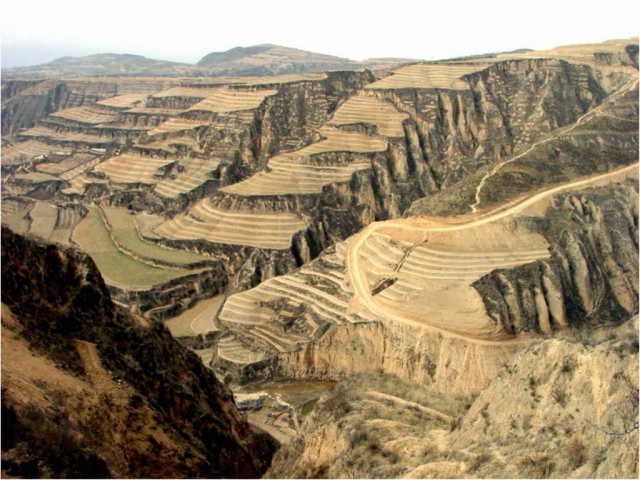loess
LOESS (PRONOUNCED “LUSS”) is a very fine light soil, often buff, yellow, or gray in color. The word stems from the German word loss or “loose,” and loess is generally easily eroded by water or blown by wind. Major loess deposits are found in Shaanxi, CHINA, in some of the U.S. plains states, notably western IOWA and western NEBRASKa, and some parts of Europe, such as central BELGIUM. Loess can mix with other soil types, yielding categories such as loess, sandy loess, and clayey loess
Recent scientific studies suggest that many of the world's loess deposits previously believed to have been transported by water were actually wind-blown (eolian) in origin. In North America, the process began during the last Ice Age, as glaciers ground rock into a fine, flour-like sediment. As temperatures rose and the glaciers melted, the “flour” was deposited on flatter terrain, where it was later blown to its current locations by the wind.

China's loess deposits are the world's thickest and most ancient. Rather than glacial dust, most of these deposits of loess soil are believed to have originated in the vast deserts of Central Asia, and to have been deposited by the wind on China's Loess Plateau, an area the size of FRANCE centered on Shaanxi Province in north central China. China's Loess Plateau has an average thickness of 492 ft (150 m), and reaching 1,082 ft (330 m) near Lanzhou on the western edge of the plateau. China's second-longest river, the HUANG (Yellow) has its headwaters on the plateau and takes its name from the color of the loess sediment it carries downstream. Some of these deposits have been dated to more than 2 million years old. Loess deposits in the Yellow River valley have historically been easily tilled with simple wooden tools, and archaeologists suggest this relates to why the birthplace of Chinese civilization is found in these areas, centered upon the ancient capitals near Xian and Loyang.
Loess also gives the Yellow River its characteristic color, and its reputation as the “sorrow of China.” As much as 1,600 tons of loess a year is carried downstream by the Yellow River, which has silt content measuring as high as 98 times that of the muddy MISSISSIPPI. When the river slows on the floodplains of central and coastal China, the loess is redeposited. Since the riverbank in these heavily populated areas is much higher than the surrounding land, disastrous floods have been a common occurrence throughout Chinese history.
Today, China's government is struggling not only to control floods downstream, but also to deal with some of the world's most severe soil erosion on the Loess Plateau, home to a population of about 40 million.